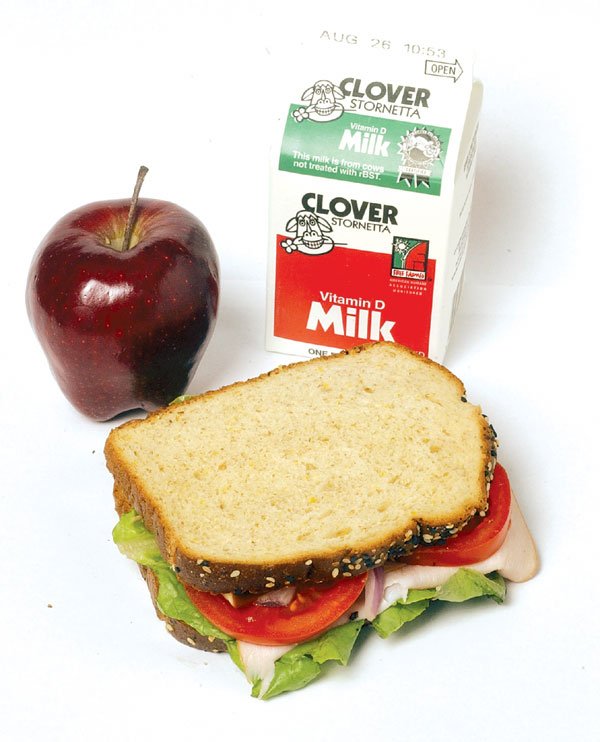Brianna Arroyo of Gilroy leans on the edge of her seat at a
spur-of-the-moment nutrition gathering conducted by Lillian
Castillo, coordinator of the Gilroy Nutrition Task Force.
”
I like hot ham and cheese for lunch at school,
”
the nine-year-old says.
”
It’s warm in my mouth.
”
Brianna Arroyo of Gilroy leans on the edge of her seat at a spur-of-the-moment nutrition gathering conducted by Lillian Castillo, coordinator of the Gilroy Nutrition Task Force. “I like hot ham and cheese for lunch at school,” the nine-year-old says. “It’s warm in my mouth.”
“Chicken patty!” puts in Amber Torres, 10, also of Gilroy. Her seatmate, seven-year-old Maria Alcantar, offers her own favorite lunch – chicken and rice. But Ramona Alcantar, Maria’s mom and a parent-volunteer, sounds a warning about the girls’ preferences for foods high in carbs and fat to the exclusion of other nutritional requirements: “More vegetables and no pizza.”
To counter today’s junk-food culture, the youngsters are being encouraged to find healthy and tasty alternatives for meals. Castillo conducts nutrition sessions once a month for about an hour and a half in the in Gilroy Unified School District’s early-learning initiative program.
Brianna suggests a fun and healthy sandwich she’d learned to make through the program, a rolled-wheat sandwich that is created by pounding bread flat and rolling it up with cream cheese, lettuce, and turkey. Fat-free popcorn sprinkled with chili powder got another rave. “Gilroy has a problem with ‘Hot Chili Cheetos,’ so I came up with this way out,” Castillo says.
“Kids are more likely to eat good foods if they prepare it themselves.”
Castillo’s advice is to avoid fatty, sugary foods such as pre-packaged “Lunchables,” sodas and chips. She recommends juices and protein-rich peanut-butter sandwiches. She also gives the thumbs-up to cake with fruit on top, or celery with peanut butter and raisins. Thumbs down to sweets, like gummy bears.
“Lunch menus should be very colorful with fruits and vegetables,” she says.
Castillo says that 50 to 70 percent of students in the GUSD qualify for free or reduced lunches. Nevertheless, almost all kids can easily access popular junk foods outside of school that are high in salt, fat and sugar – but not in nutrients.
“Most kids want foods that taste good,” says Castillo, a public health nutritionist with Santa Clara County’s Public Health Department. “But [the foods they often choose] are not high in nutrients.”
Nutrients are substances needed to nourish the body, such as protein, which builds muscle and repairs cell damage, as opposed to calories, which provide energy but if consumed in excess can cause health problems such as obesity.
“I think kids today are undernourished. They lack nutrients, but not calories,” says Jacqueline Thompson, a consulting dietitian for the San Benito Health Foundation in Hollister. “Families may have financial struggles, and healthier foods can cost more.
“Some kids are inactive, and spend too much time in front of the television. Unhealthy food choices are right in front of them on the street and at home.”
She recommends balancing children’s diets with whole-grain breads and cereals, vegetables, fruits, low-fat dairy milk and yogurt, as well as lean protein sources like chicken, fish and a moderate amount of red meat. Kids should also be drinking six to eight glasses of water daily.
“The most common vegetable in the diet is french-fried potatoes,” Thompson says, advising parents to change that trend.
Jallit Tanner, 16, of Hollister is one teen who eats right because she’s learned to like healthy foods. Jallit says she loves salads, especially spinach, and that her favorite school lunch is a submarine sandwich. Amanda Virak, also of Hollister, agrees. “If I could make my own lunch, I’d make a salad,” the 12-year-old says. She does love pizza – but with pineapple to add a bit of fruit to the meal.
Autumn Lee, 6, of Morgan Hill has her own favorite healthy snack. “I like carrots. They’re crunchy.”
Parents should create a healthy-food environment at home, says Thompson. Enjoy meals together. Limit access to soda, chips, and candy. Limit time sitting in front of the television. Join food-policy planning committees at school.
“My daughters can’t leave the dinner table without eating a vegetable or fruit,” said Colleen Fettig of Morgan Hill, mother of Erin, 8, and Caitlin, 7. “I say, ‘Eat it or else!’.” A volunteer at West Hills Community Church’s summer bible school, she says her husband, Gary, helps enforce the law of the dinner table. “That’s our rule,” Fettig says.













